Rajasthan Board RBSE Class 12 Biology Chapter 7 Transpiration
RBSE Class 12 Biology Chapter 7 Multiple Choice Questions
Question 1.
Transportation does not occur from which of the following parts?
(a) Leaf
(b) stem
(c) Root
(d) Unripe fruit
Answer:
(c) Root
Question 2.
Does maximum transpiration occur from?
(a) Stomata
(b) Lenticels
(c) Hydathodes
(d) Cuticle
Answer:
(a) Stomata
![]()
Question 3.
Hydathodes are found situated?
(a) At the margin of the leaf
(b) On the upper surface of leaves
(c) On the lower surface of leaves
(d) In the bark
Answer:
(a) At the margin of a leaf
Question 4.
The fluid secreted out through hydathodes in plants is?
(a) Pure water
(b) Only excreted substances
(c) Water and \({ CO }_{ 2 }\)
(d) Water containing organic and inorganic substances
Answer:
(d) Water containing organic and inorganic substances
RBSE Class 12 Biology Chapter 7 Very Short Answer Questions
Question 1.
How many types of transpiration is found? Name these.
Answer:
Transpiration is of three types:
- Stomatal
- Cuticular
- Lenticular
Question 2.
Maximum transpiration takes place by which processes and how much is it?
Answer:
In plants, maximum transpiration takes place through stomata and it amounts to 80 – 90% of total transpiration.
Question 3.
What is the shape of guard cells?
Answer:
Normally the guard cells are kidney-shaped.
Question 4.
Name the scientist(s) who proposed the principle of active \({ K }^{ + }\) transport.
Answer:
The theory of active \({ K }^{ + }\) uptake was proposed by Imamura and Fujino (1959) and modified by Levitt (1974).
Question 5.
Write one benefit of transpiration.
Answer:
The process of the ascent of sap in plants depends upon transpiration.
![]()
Question 6.
What is the state of guard cells at the time of opening of stomata?
Answer:
At the time of opening of stomata, the guard cells are in the turgid state.
RBSE Class 12 Biology Chapter 7 Short Answer Questions
Question 1.
Define transpiration.
Answer:
Loss of water in the form of water vapour, to the atmosphere, from the aerial parts of the plant body, is called transpiration.
Question 2.
Define guttation.
Answer:
Exudation of small droplets of liquid water and dissolved substances from the hydathodes situated at the margins and tip of leaves is called guttation.
Question 3.
Draw a labelled diagram of the stomatal apparatus.
Answer:
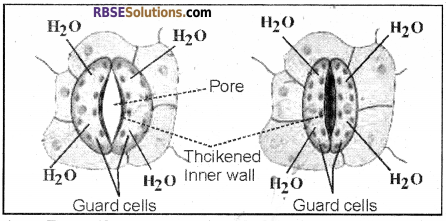
![]()
Question 4.
Describe one external factor which affects transpiration.
Answer:
Temperature affects the rate of transpiration. An increase in temperature results into decrease in relative humidity of the atmosphere and hence the rate of transpiration increases.
RBSE Class 12 Biology Chapter 7 Essay Type Questions
Question 1.
Describe the types of transpiration.
Answer:
Transpiration is of following three types:
- Stomatal transpiration
- Cuticular transpiration
- Lenticular transpiration
1. Stomatal transpiration:
Stomata are minute openings found in the epidermis of leaves and on herbaceous stems. About 90-97% of total water, absorbed by plants is lost through these openings.
2. Cuticular transpiration:
A waxy coating found on the surface of the outer wall of epidermal cells of aerial parts of plants is called cuticle.
- When loss of water occurs from the surface of leaves and herbaceous stem by direct evaporation from the epidermal cells through the cuticle, the process is called cuticular transpiration.
- The amount of water lost through cuticle is very low and varies with the thickness of cuticle and accounts only 3 to 10% of the total water loss.
- In xerophytes, a very thick cuticle is found as an adaptation to reduce cuticular transpiration.
- Transpiration from the surface of herbaceous stems, fruits and floral parts is mostly cuticular. Cuticular transpiration takes place continuously during day and night.
3. Lenticular transpiration:
Lenticels are the minute areas found in the bark of woody stem and the fruits. These are filled with loosely arranged cells known as complementary cells.
- Loss of water from lenticels is called lenticular transpiration.
- Lenticular transpiration is negligible and accounts for only 0.1% of the total water loss. This also occurs continuously during day and night.
![]()
Question 2.
Explain the mechanism of opening and closing of stomata.
Answer:
When the guard cells surrounding the stomatal pore are in a turgid state, stomata open and when the guard cells become flaccid stomatal opening gets closed.
Mechanism of Opening and Closing of Stomata:
- Opening and closing of stomata may be called stomatal movement.
- Several hypotheses have been proposed to explain the stomatal movement.
1. Starch:
Sugar hypothesis:
This hypothesis was proposed by J.D. Sayre (1923).
-
- Prior to Sayre, Lloyd (1908) showed the presence of starch in the guard cells.
- According to starch-sugar hypothesis during day time, \({ CO }_{ 2 }\) is used in guards cells in photosynthesis and pH of guard cells increases (7.0).
-
- At this pH, the phosphorylase enzyme becomes active in guard cells and starch is converted into glucose-1-phosphate.
- On account of this, DPD of guard cells increases and they become turgid due to endosmosis and stomata open.
- During the night, photosynthesis stops and \({ CO }_{ 2 }\) accumulates in the guard cells, due to which the pH of guard cells decreases (5.0).
- At this pH, glucose-1-phosphate converts into starch.
- DPD of guard cells decreases and they become flaccid due to exosmosis, causing the closing of stomata.

![]()
2. Steward’s hypothesis:
- According to this hypothesis, an increase in pH of guard cells results in the conversion of starch in glucose-1-phosphate, and then into glucose-6-phosphate which finally converts into glucose.
- Glucose and glucose-6-phosphate are more soluble in water as compared to glucose-1-phosphate.
- This results in an increase, in the osmotic concentration of guard cells leading to the opening of stomata.
- Biochemical reactions during day time:
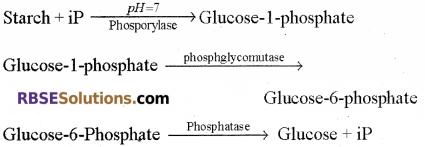
- Biochemical reactions during night time:

3. Active Potassium Ion Transport theory:
- This theory was proposed by Japanese scientists. Imamura and Fujino (1959) and were modified by Levitt (1974).
- Presently this is the most accepted theory for explaining the stomatal movement.
- According to this theory, during the presence of light malic acid is formed in guard cells which breaks into malate and in hydrogen ion (\({ H }^{ + }\)).
- These \({ H }^{ + }\) move out of guard cells and pass to subsidiary cells (influx) or epidermal cells.
- \({ K }^{ + }\) from subsidiary cells or epidermal cells move into guard cells where they react with the malate and form potassium malate.
- This increases the osmotic concentration of the guard cells.
- Increase in osmotic concentration of guard cells results into endosmosis in these cells and they become turgid causing opening of stomata.
- During night efflux of \({ K }^{ + }\) from guard cells to adjacent epidermal cells takes place.
- \({ H }^{ + }\) flow from epidermal cells into guards cells where they react with malate to form malic acid.
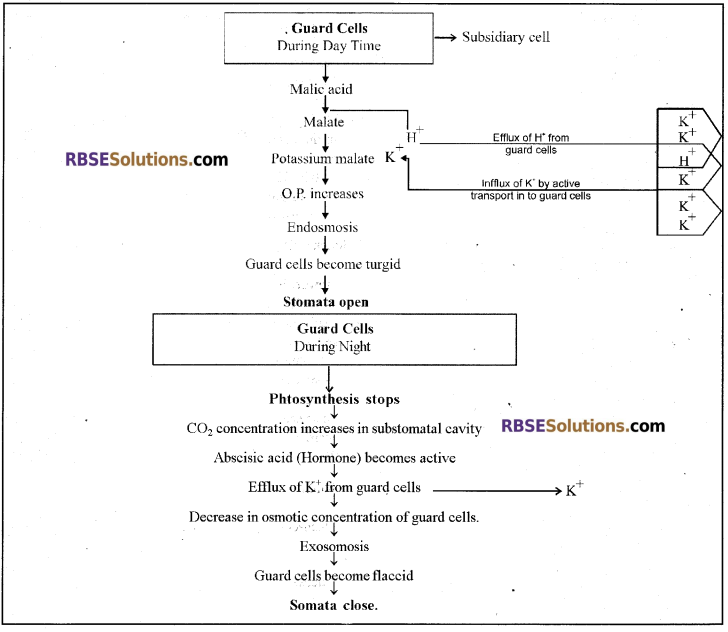
- This principle is also called as \({ K }^{ + }\) ion exchange or anion exchange or photoactive proton transport theory.
- At present this theory is the most accepted theory for explaining the opening and closing of stomata.
Question 3.
Discuss the accepted theory related to stomatal movement.
Answer:
The mechanism of opening and closing of stomata is called stomatal movement. Of various theories proposed for explaining the stomatal movement, presently active Potassium ion uptake theory is the most accepted theory.
Active Potassium Ion Transport theory:
- This theory was proposed by Japanese scientists. Imamura and Fujino (1959) and were modified by Levitt (1974).
- Presently this is the most accepted theory for explaining the stomatal movement.
- According to this theory, during the presence of light malic acid is formed in guard cells which breaks into malate and in hydrogen ion (\({ H }^{ + }\)).
- These \({ H }^{ + }\) move out of guard cells and pass to subsidiary cells (influx) or epidermal cells.
- \({ K }^{ + }\) from subsidiary cells or epidermal cells move into guard cells where they react with the malate and form potassium malate.
- This increases the osmotic concentration of the guard cells.
- Increase in osmotic concentration of guard cells results into endosmosis in these cells and they become turgid causing opening of stomata.
- During night efflux of \({ K }^{ + }\) from guard cells to adjacent epidermal cells takes place.
- \({ H }^{ + }\) flow from epidermal cells into guards cells where they react with malate to form malic acid.
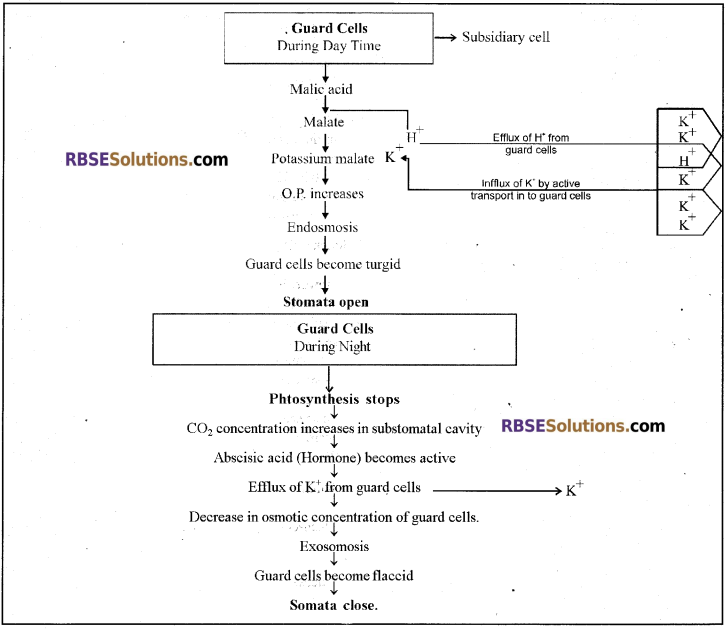
- This principle is also called as \({ K }^{ + }\) ion exchange or anion exchange or photoactive proton transport theory.
- At present this theory is the most accepted theory for explaining the opening and closing of stomata.
Question 4.
Transpiration is a necessary evil for plants. Discuss this statement.
Answer:
Transpiration is considered as beneficial for plants as well as harmful activity. In the opinion of many scientists, the process of transpiration is a necessary evil for plants because of the following aspects.
- The ascent of sap depends on transpiration pull.
- Absorption of water and minerals and their transportation is also due to transpiration.
- Transpiration has a cooling effect on leaves and the whole plant body.
- The structure of leaf favourable for entry of atmospheric \({ CO }_{ 2 }\) is also favourable for transpiration.
- In fact, no land plant can survive without transpiration.
- However, it becomes evil because it creates water deficit in the plant and injury by dehydration when available soil water decreases, and when the rate of absorption becomes low, transpiration may lead to wilting of the shoot.
- Millions of plant die, every year on account of transpiration when it exceeds absorption.
![]()
Question 5.
Describe the factors affecting transpiration.
Answer:
Transpiration is affected by the following factors:
(1) External or atmospheric factors
- Light
- Wind
- Available soil water
- Temperature
- Atmospheric pressure
- Humidity
(2) Internal or plant factors
- Leaf structure
- Leaf orientation
- Root shoot ratio
(1) External factors (Atmospheric factors):
1. Light: Light affects transpiration both directly as well as indirectly.
- Presence of light directly affects the opening of stomata and indirectly it causes a rise in temperature resulting in an increase in the rate of transpiration.
- Absence of light results into the closing of stomata and decrease in temperature hence reduces the rate of transpiration.
2. Wind: Increase in wind velocity quickly replaces humid air from the surrounding of leaves by dry air thus rate of transpiration increases in fast blowing winds.
3. Available soil water: When available soil water decreases the rate of transpiration also decreases but up to a certain limit.
4. Temperature: Increase in temperature reduces the relative humidity of the atmosphere. This results in to increase in the rate of transpiration.
5. Atmospheric pressure: Reduction in atmospheric pressure causes an increase in the rate of transpiration.
6. Humidity: Increase in humidity in the atmosphere reduces the rate of transpiration whereas when atmospheric humidity decreases, the rate of transpiration increases.
(2) Internal factors (Plant factors):
1. Leaf structure: Rate of transpiration is affected greatly by the structure of the leaf.
- Presence of sunken stomata and thick cuticle, waxy coating, and covering of hairs on leaf surface reduces the rate of transpiration.
- The number of stomata per unit area of the leaf is also an important factor. Greater is the number of stomata, higher is the rate of transpiration.
2. Leaf orientation: When leaves are oriented at the right angle of sunlight, the rate of transpiration is high.
3. Root shoot ratio: Higher is root shoot ratio higher is the rate of transpiration.
![]()
Question 6.
Write a note on guttation.
Answer:
Water loss in the form of small droplets from hydathodes situated on the tip and margin of leaves is called guttation.
Guttation:
- De Barry (1869) first observed this process.
- Exudation of droplets of water from the tips and margins of leaves is called guttation.
- This loss occurs through minute openings found at the terminal ends of the veins of leaves of some plants. These openings are called hydathodes.
- The pore of hydathode is called water pore and is an incompletely differentiated stoma.
- These are permanently open pores because the two cells surrounding the pore are incapable of movement.
- A group of thin-walled loosely arranged parenchyma cells is present below the hydathode. This is called epithem.
- The tracheary elements of veins terminate or end just close to the epithem tissue.
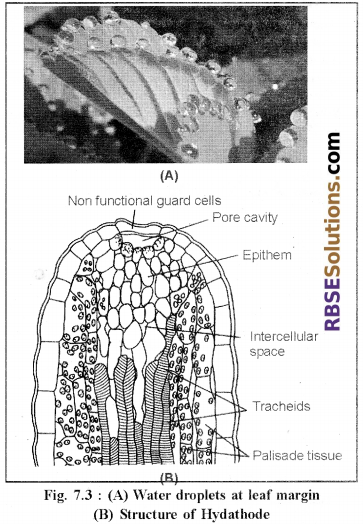
- When water absorbed by roots exceeds transpiration, root pressure develops and water from xylem vessels and tracheids is pushed in the epithem tissue.
- Finally, water is exuded out in the form of droplets through the pore. Thus guttation is an expression of root pressure.
- Guttation takes place more during the night and early morning hours. Eg. Tomato, grasses, Potato, Bryophyllum, Colocasia etc.
- The fluid lost in guttation is not pure water but contains dissolved minerals and some organic substances also.
- Deposition of minerals and organic substances on the surface of leaves may result in injurious effect and may provide a medium for a pathogenic attack.